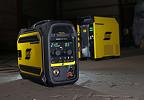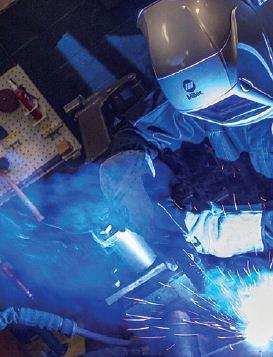- FMA
- The Fabricator
- FABTECH
- Canadian Metalworking
Weld Safe
Welding safety is as important as welding quality.
- By Nestor Gula
- October 8, 2015
- Article
- Welding
Getting a proper weld bead is essential to joining metal together, but even more important is the safety and well-being of the ones who are doing the welding.
Welding safety has advanced a great deal since the early days, but that does not mean people should be lackadaisical about the precautions they take. Too often welders in small shops will lay down a few beads without proper clothing, and one type of protective clothing might not be suitable for all welding applications.
“While lightweight gloves and welding sleeves paired with a long sleeve T-shirt work for TIG welding to protect from the heat and arc rays, that set-up does not work for overhead MIG or stick welding due to the possibility of spatter and slag falling on the welding operator,” says Eric Sommers, product manager, weld safety - head and face protection for Miller Electric. “In these applications, heavy-duty MIG/Stick gloves and a full leather coat are the recommended attire. There are many other configurations such as combination leather and cloth jackets, thinner engineered flame-retardant materials and basic flame retardant cotton that can also be used for the appropriate conditions.”
Understanding the risks associated with the welding being done will help operators choose the proper protective clothes. “A welder working long hours in a heavy-duty MIG/MAG application, should consider thick leather garments/aprons because the resulting sparks and spatter are hotter and burn through quicker than in other applications,” says Guy Shelverton, global product manager, welding personal protective equipment (PPE) for ESAB. “In contrast, a TIG welder or the occasional hobby welder may be better suited to wearing a thinner FR (Flame Resistant) garment. Also consider the welder’s position when working, there may be a potential that sparks will fall onto the welder in places that require additional protection. PPE clothing options like ankle gaiters, tightly collared garments, welding sleeves and hoods can be added for extra protection.”
Besides safety, consideration must be taken into account for the welders’ comfort. Bulky ill-fitting clothing will effect performance and can lead to worker distress that can cause defects in the work piece and even accidents.
“Synthetic materials should not be worn around welding, however, long pants such as jeans are appropriate provided they are long enough to extend over the top of the welding operator’s work boots to prevent sparks from entering the boot,” says Sommers.
“Leather work boots should also be the minimum used while welding, with lace-less Wellington style boots or traditional work boots with metatarsal guards providing the best protection from sparks entering the boot.”
Glove it
Gloves are an aspect of protective wear that is often not highly considered. Standard off-the-shelf work gloves are not recommended for welding work. “The two main types of welding gloves, MIG and TIG gloves, are most commonly made from leather,” says Shelverton. “The MIG glove is usually made from a cow hide and offers good protection for heavier duty applications, protecting the hand and wrist from heat, spatter and sparks.
“The TIG glove is typically made from softer, thinner leather (goat or pig), because in these applications it is important for the welder to have better dexterity in the fingertips. Also, TIG welding normally poses less threat of heat and spatter.”
For TIG welding, docile flexible gloves that provide proper protection are essential. “Significant advancements have been made in glove construction, which allow gloves to provide enhanced dexterity while also maintaining, and even exceeding, the protection provided by traditional weld gloves,” says Sommers. “TIG welding, for example, requires a high level of dexterity to properly manipulate the torch and apply the filler metal during the weld — in this application a thin, tight-fitting and flexible glove is optimal.
For MIG and stick welding, the gloves can cross over in use and range from unlined up to heavily insulated styles depending on the amperage and, therefore, the heat that the operator is exposed to during welding. Glove cuff lengths can also vary depending on the protection required for the specific application.”
Fume
When welding there are fumes which can be potentially toxic. No one denies this, and a great deal of care must be taken to minimize the risk to the workforce. “Welding operators should take it upon themselves to understand the importance of avoiding fumes in their breathing zone,” says Allan Hilbert, the Filtair product manager for Miller Electric. “The government enforces regulations and companies follow recommendations for fume control, because research has shown that workers who protect themselves feel better, have fewer sick days and are more productive. Knowing the potential dangers of breathing weld fume is the first step to preventing both short and long term health effects.”
Fume extraction can be roughly divided into two areas: individual/localized fume extraction and whole fume plant extraction systems. “Fume extraction is a critical part of health and safety protection because it is the first consideration in ensuring the welding fume exposure is reduced to a minimum within the immediate environment of the welder,” says Shelverton. “While fume extraction installations can be complex and expensive, there are many models of more portable plug-and-play systems available. In many cases though, users go straight to PPE without considering fume extraction. This unfortunately may cause a higher level of exposure to the welder and more widespread fume exposure to others in the area surrounding the work.”
Choosing between systems is a choice made by the application. “It depends on the size of the weldment and the types of welding positions that are required to perform the task,” says Hilbert. “Individual fume extraction points, or source capture, are the recommended method preferred by safety professionals since it captures the fume directly at the source before it can enter the welding operator’s breathing zone.
“When using whole plant systems, it is very important to understand that these systems do not protect the welding operator’s breathing zone. Once the fume escapes the source, it become much more inefficient to capture and filter. The higher airflow needed to sufficiently change over all the cubic air volume in a large plant five to seven times an hour requires much more horsepower than it does to target the source and capture the fume as it is being created.”
The right fume extraction equipment depends on the plant and the type of welding being performed. Simple, portable, fume extraction units that are on the market may be the easiest and quickest solutions for many shops. “If welders are moving around, then an individual, portable system makes sense,” says Shelverton. “Not only do they roll to the work area, their articulated suction hoods can be positioned in the ideal location to draw fumes away from the welder. If there are multiple welding bays constantly in use, then it probably makes better sense to have a dedicated, whole plant fume extraction system with fixed drop-down ducts and collection hoods.”
About the Author
subscribe now


Keep up to date with the latest news, events, and technology for all things metal from our pair of monthly magazines written specifically for Canadian manufacturers!
Start Your Free Subscription- Trending Articles
CWB Group launches full-cycle assessment and training program

Achieving success with mechanized plasma cutting

3D laser tube cutting system available in 3, 4, or 5 kW

Brushless copper tubing cutter adjusts to ODs up to 2-1/8 in.

Welding system features four advanced MIG/MAG WeldModes

- Industry Events
MME Winnipeg
- April 30, 2024
- Winnipeg, ON Canada
CTMA Economic Uncertainty: Helping You Navigate Windsor Seminar
- April 30, 2024
- Windsor, ON Canada
CTMA Economic Uncertainty: Helping You Navigate Kitchener Seminar
- May 2, 2024
- Kitchener, ON Canada
Automate 2024
- May 6 - 9, 2024
- Chicago, IL
ANCA Open House
- May 7 - 8, 2024
- Wixom, MI


















